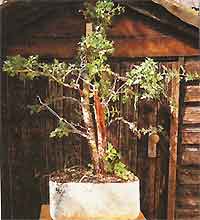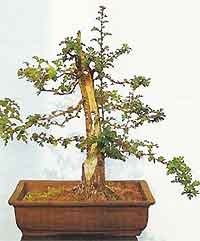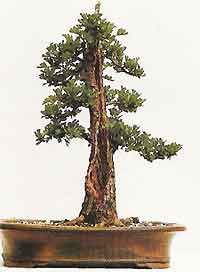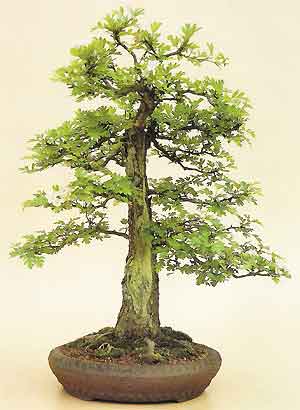Bonsai Trees
Case Histories
Common Hawthorn - (crataegus monogyna)
Hawthorn Bonsai Style: Informal Upright

This hawthorn was found growing on a derelict building site, where it had been struggling for many years. The site was exposed and consequently the growth had developed more sideways than upwards. Being nearly 2 metres wide (6 feet) and yet just 1 metre high (3 feet), it was a most unusual shape for a hawthorn. The trunk immediately took my eye, as it was quite large and covered with wonderfully textured bark. It was obviously an old tree.
What a find, and it was a twin trunk as well! As the tree looked like it would have a large tap root, I decided to collect it a year later and dug a trench around it to help with the development of fibrous roots. The following year I returned in the spring to find it covered in berries. I was delighted as I am convinced that there are some hawthorns that just do not flower - ever! Not this tree though, there was the proof!
Hawthorn Bonsai History: Training

Potted up in a big plastic tub I began to have second thoughts. After all the planning and effort to collect the tree, the twin trunk arrangement was not pleasing to the eye. Both of the trunks were exactly the same size, shape and were parallel. Would this hawthorn ever make a good bonsai? I really wasn't sure, but I thought that if the tree lived, I would certainly start training and see what happened.
After growing on for two years it was time for some basic structuring. There was a definite main trunk so I reduced the height of the second trunk, slightly carving it. I was not happy with the result, but lived with it for a couple of months while I rethought my plans. I decided that this tree had no future as a twin trunk and so one of the trunks would have to go - but which one? The second trunk was chosen to remain as it had a more interesting shape and I was also pleased with the carving that I had done. I thought about my decision once more and quickly sawed the main trunk off before I changed my mind!
One year later and the tree was repotted into a bonsai pot. A very open soil mix was used as despite much growth during the previous year, the roots had not thrived. Two years on and the roots were still not strong. The tree appeared healthy and was growing well, but there were very few fibrous roots. I changed the pot and soil mix, using mainly akadama and grit.

By now I had found the perfect pot, one that had been handmade in Japan. It complemented both the colour and texture of the trunk, but I would only use it if the roots were in good shape as being smaller, the pot necessitated much root pruning.
I was delighted to find the tree completely pot bound with an abundance of healthy, fibrous roots. The new, much smaller pot provided more emphasis on the strong trunk line and good surface roots.
It made the tree look much larger and I was happy with the overall presentation. The branches were heavily wired and positioned and now just need extra thickness to balance the weight of the trunk.
There was no doubt that the hawthorn was healthy and happy and the autumn colour was most rewarding, but would it ever flower?!

The following spring the tree was exhibited for the first time, at a National exhibition. I decided not to repot until flowers appeared, hoping to encourage this by keeping it pot bound. Also bone meal was applied in the autumn and high potash fertilizers in the spring, but the only buds that appeared were leaf buds! The foliage masses were thinned out so that the balance with the hollowed trunk was maintained.
In the spring two years later I decided that although there has been no sign of flowers, the hawthorn needed to be repotted as it was obviously very pot bound. By now I had given up on the idea of flowers. Maybe it just wasn't going to happen - and then it did! Only one flower, but the next year there were many more.
 This hawthorn was found growing on a derelict building site, where it had been struggling for many years. The site was exposed and consequently the growth had developed more sideways than upwards. Being nearly 2 metres wide (6 feet) and yet just 1 metre high (3 feet), it was a most unusual shape for a hawthorn. The trunk immediately took my eye, as it was quite large and covered with wonderfully textured bark. It was obviously an old tree.
This hawthorn was found growing on a derelict building site, where it had been struggling for many years. The site was exposed and consequently the growth had developed more sideways than upwards. Being nearly 2 metres wide (6 feet) and yet just 1 metre high (3 feet), it was a most unusual shape for a hawthorn. The trunk immediately took my eye, as it was quite large and covered with wonderfully textured bark. It was obviously an old tree. Potted up in a big plastic tub I began to have second thoughts. After all the planning and effort to collect the tree, the twin trunk arrangement was not pleasing to the eye. Both of the trunks were exactly the same size, shape and were parallel. Would this hawthorn ever make a good bonsai? I really wasn't sure, but I thought that if the tree lived, I would certainly start training and see what happened.
Potted up in a big plastic tub I began to have second thoughts. After all the planning and effort to collect the tree, the twin trunk arrangement was not pleasing to the eye. Both of the trunks were exactly the same size, shape and were parallel. Would this hawthorn ever make a good bonsai? I really wasn't sure, but I thought that if the tree lived, I would certainly start training and see what happened. By now I had found the perfect pot, one that had been handmade in Japan. It complemented both the colour and texture of the trunk, but I would only use it if the roots were in good shape as being smaller, the pot necessitated much root pruning.
By now I had found the perfect pot, one that had been handmade in Japan. It complemented both the colour and texture of the trunk, but I would only use it if the roots were in good shape as being smaller, the pot necessitated much root pruning. The following spring the tree was exhibited for the first time, at a National exhibition. I decided not to repot until flowers appeared, hoping to encourage this by keeping it pot bound. Also bone meal was applied in the autumn and high potash fertilizers in the spring, but the only buds that appeared were leaf buds! The foliage masses were thinned out so that the balance with the hollowed trunk was maintained.
The following spring the tree was exhibited for the first time, at a National exhibition. I decided not to repot until flowers appeared, hoping to encourage this by keeping it pot bound. Also bone meal was applied in the autumn and high potash fertilizers in the spring, but the only buds that appeared were leaf buds! The foliage masses were thinned out so that the balance with the hollowed trunk was maintained.